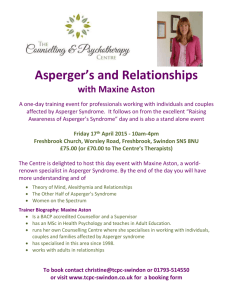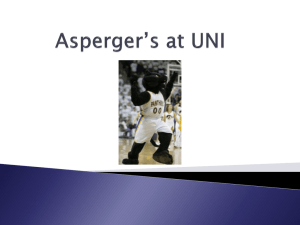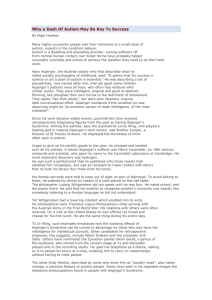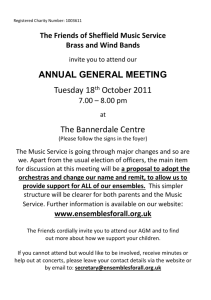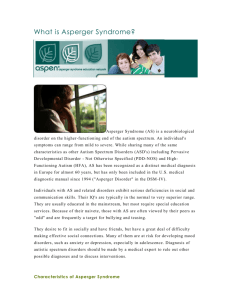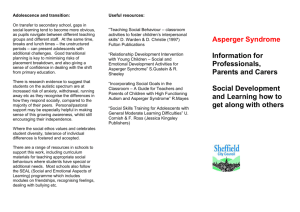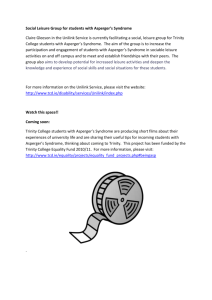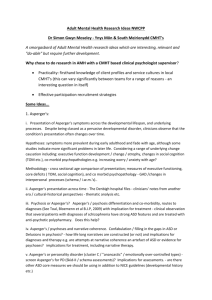Look Me In the Eye - John Elder Robison
advertisement
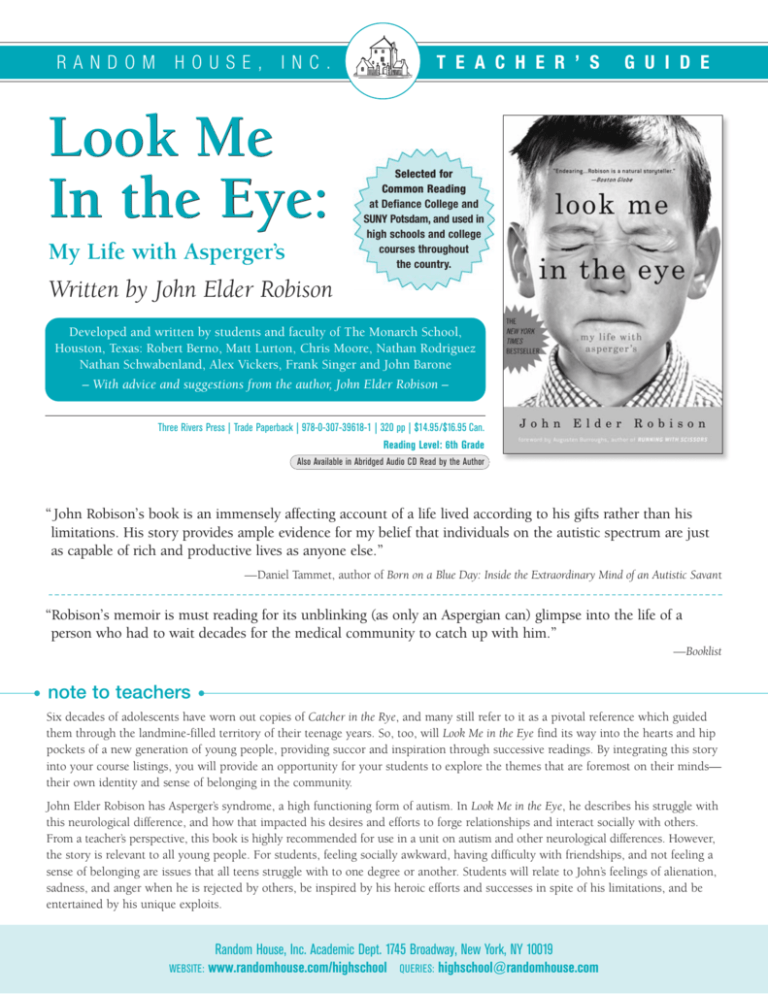
RANDOM HOUSE, INC. Look Me In the Eye: My Life with Asperger’s T E A C H E R ’ S G U I D E Selected for Common Reading at Defiance College and SUNY Potsdam, and used in high schools and college courses throughout the country. Written by John Elder Robison Developed and written by students and faculty of The Monarch School, Houston, Texas: Robert Berno, Matt Lurton, Chris Moore, Nathan Rodriguez Nathan Schwabenland, Alex Vickers, Frank Singer and John Barone – With advice and suggestions from the author, John Elder Robison – Three Rivers Press | Trade Paperback | 978-0-307-39618-1 | 320 pp | $14.95/$16.95 Can. Reading Level: 6th Grade Also Available in Abridged Audio CD Read by the Author “ John Robison’s book is an immensely affecting account of a life lived according to his gifts rather than his limitations. His story provides ample evidence for my belief that individuals on the autistic spectrum are just as capable of rich and productive lives as anyone else.” —Daniel Tammet, author of Born on a Blue Day: Inside the Extraordinary Mind of an Autistic Savant “Robison’s memoir is must reading for its unblinking (as only an Aspergian can) glimpse into the life of a person who had to wait decades for the medical community to catch up with him.” —Booklist note to teachers Six decades of adolescents have worn out copies of Catcher in the Rye, and many still refer to it as a pivotal reference which guided them through the landmine-filled territory of their teenage years. So, too, will Look Me in the Eye find its way into the hearts and hip pockets of a new generation of young people, providing succor and inspiration through successive readings. By integrating this story into your course listings, you will provide an opportunity for your students to explore the themes that are foremost on their minds— their own identity and sense of belonging in the community. John Elder Robison has Asperger’s syndrome, a high functioning form of autism. In Look Me in the Eye, he describes his struggle with this neurological difference, and how that impacted his desires and efforts to forge relationships and interact socially with others. From a teacher’s perspective, this book is highly recommended for use in a unit on autism and other neurological differences. However, the story is relevant to all young people. For students, feeling socially awkward, having difficulty with friendships, and not feeling a sense of belonging are issues that all teens struggle with to one degree or another. Students will relate to John’s feelings of alienation, sadness, and anger when he is rejected by others, be inspired by his heroic efforts and successes in spite of his limitations, and be entertained by his unique exploits. WEBSITE: Random House, Inc. Academic Dept. 1745 Broadway, New York, NY 10019 www.randomhouse.com/highschool QUERIES: highschool@randomhouse.com note to teachers (continued) After Look Me in the Eye was published, the author received many invitations to visit schools to share his inspirational message. One of those invitations came from The Monarch School in Houston, Texas. Monarch is dedicated to providing an innovative, therapeutic education for children with neurological differences, like Asperger’s syndrome. Monarch was so impressed with John and his inspirational message, that they invited him back to their graduation in May 2008, to receive an honorary high school diploma. It was an exciting moment when he proudly walked across the stage in his cap and gown to receive the diploma that he so richly deserved. That spring, a group of Monarch students began reading and discussing Look Me in the Eye as a part of their language arts curriculum. The students found John’s story particularly relevant as they, too, struggled with Asperger’s and other differences. With the help of their teachers, these students have worked to identify themes, compose questions, and create activities for each chapter. This teacher’s guide is the collaborative result. about the book John Elder Robison’s story is one of alienation, desperate loneliness, and an intense desire to connect with others in spite of poor social skills. His clumsy attempts at relationship-building are chronicled throughout the memoir. As a toddler, he is taught to “make friends” with a dog by petting it. When he applies the same practice in his efforts to befriend a little girl on the playground, he is discouraged when she smacks him. Undaunted, he modifies his strategy by using a stick to pet her, and is crushed and confused when his efforts are rejected and a teacher scolds him. John’s struggle is compounded by an unstable, dysfunctional home environment. Growing up in the household described by his brother, Augusten Burroughs, in the bestselling Running with Scissors, John’s difficulties are worsened by abuse and neglect. John describes in vivid detail the “pranks” he engineered as a teenager, that were born from the anger that grew inside him from years of rejection and failure. Some of these, in fact, were serious crimes that could have resulted in devastating consequences. Just as Holden Caulfield yells, “Sleep tight, ya morons!” and abandons his dorm at Pencey Prep for the wild streets of New York, John’s feelings of alienation and his misfit self image lead him to drop out of high school for an exciting and sometimes dangerous life in the music business, working for bands like KISS and Pink Floyd. The rest of the story is an inspiring tale of self-discovery, as John learns through trial and error and misadventure to understand himself and others, and to begin to forge real friendships for the first time. By slowly identifying his strengths and weaknesses, he experiences both dismal failures and tremendous successes. The author’s salvation comes after a diagnosis of Asperger’s syndrome at the age of 40. With great joy, John discovers that his social awkwardness, inability to look people in the eye, and difficulty making and keeping friends were not because he was a failure or misfit, but are, instead, symptoms of this neurological difference on the autistic spectrum. Thus, he sheds years of guilt and shame, and is fueled by a new awareness and understanding that his way of thinking and relating are not bad or wrong, just different. With this new confidence, John builds a life that is successful and fulfilling. random house, inc. teacher’s guide 2 about the author JOHN ELDER ROBISON was born in 1957 in Athens, Georgia to John G. Robison, a college professor, and Margaret Robison, an author and artist. John’s brother, Chris, changed his name to Augusten Burroughs, and is the author of the best selling, Running with Scissors. Look Me in the Eye: My Life with Asperger’s is John Robison’s first book. In addition to being an author, he owns and runs J E Robison Service Company, an automobile repair and restoration service. John lives in Massachusetts with his wife and teenage son. To the extent possible, John responds personally to student and teacher queries, through his blog, jerobison.blogspot.com, his website, www.johnrobison.com and pages on Facebook and other social networking sites. discussion and activities Forword: John’s brother, Augusten Burroughs, describes their dysfunctional family, and affectionately details his love/hate relationship with his big brother. Prologue: The author provides the source of the book’s title, describing how adults grew angry with him for not looking them in the eye. This characteristic, typical of those with autism, is described by John as leading to others judging him as deviant. A description of the diagnosis of Asperger’s syndrome follows, with John’s assertion that he is proud to be “Aspergian.” Questions: 1. How did John’s father and others react when John didn’t look them in the eye? Did John deserve this reaction? Explain. 2. What is Asperger’s syndrome? What are some of the challenges of living with Asperger’s? What are some of the possible benefits? Activities: 1. Long-Term Project: Have students research the diagnostic criteria for Asperger’s syndrome, and, as they read the book, look for and record characteristics that John presents that are consistent or inconsistent with the diagnosis. Chapter 1: A Little Misfit Theme: Making Friends Summary: As a young child, John’s autism causes him to be rigid and inflexible when trying to play with his peers. He rejects other children who aren’t playing “correctly,” and is, himself, rejected by others when he attempts to interact. These difficulties are compounded by his dysfunctional home life. Questions: 1. What are your earliest memories of playing with other children? Did you experience anything similar to what John experienced? Who were the adults whom you went to for guidance? 2. John got along better with adults than children. Why do think this is so? 3. Several times, John shared a preference for inanimate objects (blocks, machines, etc.) over humans, because of their dependability and because they couldn’t hurt him. Can you understand why John felt this way? Have you ever had similar feelings? www.randomhouse.com/highschool • highschool@randomhouse.com 3 discussion and activities (continued) Activities: 1. Invite each student to identify in parallel structure John’s and his or her: a. first playmate; b. first large group interaction; c. quirky behaviors as a young child. 2. Explore John’s preference for inanimate objects by role-playing scenes in which the students are friends with a rock (or another inanimate object) and are: a. going to the movies; b. having a heart to heart talk, talking about their day; c. playing “cowboys and Indians” (as John did in the book). 3. “Prove them wrong” writing activity: Write about a goal that you achieved in spite of others telling you that you couldn’t do it. Chapter 2: A Permanent Playmate Theme: Social Interaction Summary: John discusses feeling “defective” as a small boy, because he didn’t measure up to other children. John’s baby brother is born, whom he quickly nicknames “Snort,” and later, “Varmint.” He begins to look for “usefulness” in his new sibling, and rushes his brother’s development, pushing him to walk before he’s ready, and being rough with him (e.g., flipping him over like a turtle when he crawls). Questions: 1. John describes his “defective” self-image as a young boy. Now he sees himself as “different.” Do you have characteristics that you once thought were defects that you now understand to be differences? 2. Are there peers in your school whom you have judged as “defective”? What “differences” might account for their unusual behavior? Activities: 1. Read John’s account of his typical responses to: “Look at my Tonka Truck”: a. “I have a helicopter.” b. “I want some cookies.” c. “My mom is mad at me today.” d. “I rode a horse at the fair.” Then do an exercise in which you read an opening conversational comment and invite students to respond first in a “disconnected” way and then in a “connected way.” Opening comments: a. “Nice day today, isn’t it?” b. “I really enjoy watching baseball games.” c. “I think this birthday cake is delicious.” random house, inc. teacher’s guide 4 Chapter 3: Empathy Theme: Care for Others in Crisis Summary: John shares a story of smiling in response to hearing that another child had been killed, and explains his thought process in the interaction. He reflects on the difference between care that is felt strongly when someone close to him is in danger, and the “logical empathy” he experiences when becoming aware of a crisis involving people with whom he is not personally involved. Questions: 1. Have you ever smiled or laughed at an inappropriate time? Share the story. 2. How do you feel when you hear about strangers losing their lives in another country? Would it be different if those same people lived in your town? In your neighborhood? 3. Talk about a time when your feelings didn’t match what people expected you to feel. Activities: 1. Invite students to bring to class a newspaper or Internet news story about a crisis (or provide stories for them). Share the stories and compare reactions. Look for differences in emotional responses to crises that are “closer to home.” Chapter 4: A Trickster Is Born Themes: Practical Jokes, Humor vs. Harm Summary: John describes often pulling “pranks” on peers, family members, and others, that ranged from harmless to hurtful. The acceptance he felt from peers in response to his actions encouraged him to be a prankster. Questions: 1. Share a story of a time when someone played a “joke” on you. Did you think it was funny? How did others react? 2. Have you ever played a joke on somebody else that was cruel? How did you feel about it at the time? How do you feel about it now? Activities: 1. Cool or Cruel a. Divide the room into two sections, with one side representing “cool” and the other “cruel.” Instruct students to walk to the section of the room which represents how they feel about the pranks. Let them know that there are varying degrees within each section. b. Read the following “pranks” that John shared in the book; allow students to move to the section reflecting their judgment of the prank, and invite them to share why. i. Leading his mother to believe that his little brother had been kidnapped; ii. Asking for donations for an orphan fund and using the money to buy pornography; iii. Using the pornography to potentially hurt his parents’ marriage and attack a teacher’s reputation. c. Continue the exercise by reading the following “pranks” that high school students might pull, or add your own: i. Taking out a personal ad for someone else on a dating website; ii. Toilet papering someone’s yard; iii. Putting salt in the sugar bowl; iv. Putting hair removal cream in someone’s shampoo. d. Conduct a discussion of how to determine whether a prank is harmless and humorous, or hurtful. www.randomhouse.com/highschool 5 discussion and activities (continued) Chapter 5: I Find a Porsche Themes: Affinities, Career Paths, Good Deeds for Personal Gain Summary: John moves to a wooded area and starts finding abandoned cars. His fascination with automobiles continues to grow. He washes his grandfather’s Porsche and tractor in an effort to get his grandfather to give him the Porsche. Questions: 1. When John discovered his passion for automobiles, what impact did it have on his imagination, his happiness, and his relationships? 2. What in your life do you feel as passionately about as John does about automobiles? Does this passion bring you opportunities to share joy with others, e.g., playing basketball, or does it isolate you from others, e.g., playing computer games alone? 3. John’s love of automobiles led him to a successful career with his auto restoration and repair business. What career path might you follow based on your current passions? Activities: 1. Read the excerpt on page 48 about John washing and waxing the car and tractor in an attempt to get his grandfather to give him the Porsche. Lead a discussion about good deeds and the motivation for doing them. Discuss instrumental functioning that is common to Asperger’s syndrome. Chapter 6: Nightmare Years Themes: Alcoholism, Mental Illness, Abuse Summary: John’s family life worsens. His father begins drinking more, and becomes more violent and abusive. John fantasizes about attacking his dad, but doesn’t do it, out of fear that he wouldn’t be successful. His mother begins hallucinating, and the family begins visiting Dr. Finch. John expresses his anger by destroying his brother’s toys. Questions: 1. What do you think it was like for John, growing up being afraid of his father? 2. How did John express his feelings? 3. What effect does alcoholism have on relationships? How did John’s father’s alcoholism affect John? How would you have reacted to it? Activities: 1. Research child protective laws and practices and determine whether John’s father’s actions would be considered abuse in your area. Discuss the impact of this abuse on John’s development. 2. Explore Dr. Finch’s treatment through role play or a writing assignment. Invite students to, in turn, take on the roles of John’s father, John’s mother, John, and Dr. Finch in their evaluation of the therapeutic approach and techniques that Dr. Finch used, e.g., allowing John to call his parents “Stupid” and “Slave.” random house, inc. teacher’s guide 6 Chapter 7: Nightmare Years Themes: Coping with Troubles through Achievement, Asperger’s Characteristic of Preoccupation, Failures Which Lead to Success Summary: At the age of 13, John receives an electronics kit for Christmas, and starts studying electronics in school and on his own. He tries to learn bass, and plays poorly, but then finds his calling when he redesigns an amplifier. John’s family life continues to deteriorate. John meets and befriends Mary (Little Bear), whom he will later marry. Questions: 1. How did John’s electronics kit change his life? Have you ever received a present that had a significant impact on your future? 2. What characteristic of Asperger’s did John show in his pursuit of knowledge of electronics? 3. How did John’s passion for electronics help him cope with his family problems? Do you have any interests that help you cope when things aren’t going well in your life? Activities: 1. Bad News/Good News: Trying new things can lead to unexpected benefits. Ask the students to share times when they’ve experienced struggle or failure that ultimately led them to experience something positive in their lives. Chapter 8: The Dogs Begin to Fear Me Themes: Aggression Resulting from Rejection, Followed by Restitution and Repair Summary: John talks about the “dark side” of Asperger’s and how other’s rejection of him made him respond aggressively. He describes driving his grandfather’s car and accidentally backing into a ditch and knocking over a mailbox. After seeing his grandfather use post hole diggers to repair the mailbox, John becomes obsessed with digging holes, and designs a pit trap. He goes on to describe faking a ritual hanging. Questions: 1. What is John’s reaction when he backs into the ditch and knocks over the mailbox? How would you have reacted? 2. What responsibilities do we have when we hurt things or people? How can we repair and make restitution for the damage we cause? 3. Did John cause damage when he put his brother in the hole? When he made a pit trap? When he did the ritual hanging prank? 4. What damage might have been caused by these pranks? After reflecting on the possible harm, does that change how you feel about whether the pranks were right or wrong? Activities: 1. Harmful or Harmless: Invite students to consider each prank that John describes in this chapter, asking for a “thumbs up” if they think the prank is harmless or a “thumbs down” if they think the prank is harmful. After each description, add increasingly serious, possible consequences that may have resulted from the pranks, e.g., with the pit trap, a broken leg, or even broken neck. Ask them how they would react if they had been the victim of these pranks. 2. Consider the relationship between pranks like John describes and school violence today. When John was a child, there was considerably more tolerance for pranks of all kinds, yet serious violence in schools and among American youth in general was very rare. Today, that situation is reversed. Why might that be? www.randomhouse.com/highschool 7 discussion and activities (continued) Chapter 9: I Drop Out of High School Themes: Characteristics of Autism, judgment of Behavior As Willful As Opposed to Developmental Summary: John’s parents ignore him and his little brother and became more abusive to one another. Both get worse and have to be admitted to institutions. John shares autistic characteristics that others have criticized (staring, not looking others in the eye, bobbing), and attends a support group for troubled teens. John flunks all his classes, is offered the GED, which he aces, but refuses to pay the $20 fee to graduate. John meets and learns outdoor skills from Paul, a Vietnam veteran living in the woods. Questions: 1. What characteristics of Asperger’s does John describe in this chapter? 2. How did others view these characteristics? 3. Why do you think John refused to pay the $20 to get his diploma? What would you have done, and why? Activities: 1. Character vs. Developmental Frame: Brainstorm with the class a list of John’s characteristics. Then discuss each characteristic as a function of character or of development. For example, judging John’s inability to look others in the eye as a function of his character might result in a description such as “rude” or “disrespectful,” whereas a developmental description would describe the behavior as a difference resulting from John having Asperger’s. 2. In small groups, invite the students to discuss times when their behavior has been judged as willful, when in fact it was something they could not control. Chapter 10: Collecting the Trash Themes: Imagination and Creativity, Responses to Snobbery Summary: John goes to a party with his parents’ friends and weaves an outrageous, shocking tale of his job as a garbage collector. Questions: 1. Describe the guests’ treatment of John. How would you have felt in his place? 2. Do you think that John’s outrageous story was an appropriate or inappropriate response to the way he was treated? Why? Activities: 1. Truth or Lie: Invite members of the class to share three things about themselves, two of which are true, and one of which is false. Have the others students try to identify the “lie.” 2. Have students write/share a hard to believe story about themselves, which may or may not be true. Invite them to read their stories to each other and try to determine whether the stories are true or false. Chapter 11: The Flaming Washtub Themes: Dangerous Hobbies, Romantic Rejection Summary: John and his friend start a serious fire with a homemade furnace while trying to melt metal. Little Bear tells John she never wants to see him again. John is crushed. She refuses to talk to him. John’s parents separate, and his father tries to kill himself. John and his father stop seeing Dr. Finch. John becomes more involved in the music business. random house, inc. teacher’s guide 8 Questions: 1. What were the risks involved in operating the homemade furnace? Did John and his friend consider those risks before operating the furnace? No one was hurt, but what might have happened? 2. How do you think his father’s suicide attempt impacted John? 3. Do you think it was a good or bad decision for John and his father to stop seeing Dr. Finch? Explain. Activities: 1. Brainstorm a list of causes that might have led to John’s and Little Bear’s breakup. 2. In small groups, invite students to share the reasons that relationships come to an end. 3. Discuss with the large group things that John and Little Bear might have done differently to preserve their relationship. Chapter 12: I’m in Prison with the Band Themes: Living Away from Home, Relationship Skills, Risk Behaviors Summary: John gets more involved in the music business and moves in with band members. He accompanies the band to Montserrat, and does not enjoy himself because of the many changes in his routine, diet, etc. He is arrested with the band for drug possession, but is eventually released. John returns to the States, and grows more confident with his engineering skills, but still has no confidence when it comes to relationships. Questions: 1. How was John’s first experience of living away from home? Describe how your first year away from home will be. What are some things you can do now to prepare for that time? 2. What characteristics of Asperger’s prevented John from having a good time in the tropical paradise? How did those same characteristics protect him from some of the risky behaviors exhibited by the others who were with him? Activities: 1. Invite the class to rewrite and/or retell the story of John’s visit to the tropical island had he not had Asperger’s. 2. Lead a discussion on how some characteristics of Asperger’s can be positive, and identify those autistic characteristics that helped John throughout his life. Chapter 13: The Big Time Themes: Reconciliation, Rumors and Gossip, Achievement of Greatness in Spite of Challenges Summary: John reconnects with Little Bear, and spends the summer collecting railway spikes and glass telegraph insulators. John is hired by a national sound company, and designs original sound systems for big name bands like Pink Floyd. Questions: 1. Name the three top music acts today. Would you want to work/travel with them? Why/Why not? 2. What would you have done differently than John did with the band? 3. John had tremendous success in spite of his challenges. Share an accomplishment of yours that you achieved in spite of obstacles or difficulties. Activities: 1. This was an idyllic time for John: doing an important job, being in love, and not having to worry about his family. Invite students to share stories of carefree times they may have experienced in their lives. 2. Describe John’s reconciliation with Little Bear, and invite students to share in small groups how rumors and gossip can impact relationships. www.randomhouse.com/highschool 9 discussion and activities (continued) Chapter 14: The First Smoking Guitar Themes: Innovation, Creativity, Fear of Failure, Uniqueness Summary: John finds more success designing guitars for KISS. He feels he fits in better, as he sees the rockers as misfits like himself. Questions: 1. Even though John was exceptionally gifted in his ability to design special effects guitars, he was terrified they would fail. How do John’s self image and his relationships with others impact his confidence? 2. Identify some innovative ideas that John brought to the band, KISS. Talk about a school project you did that was creative and innovative. Activities: 1. In small groups, invite the students to describe the group of people with whom they feel most comfortable. Ask them to explore why they feel comfortable in those groups, and relate to John’s experience hanging out with people in the music business. Chapter 15: The Ferry to Detroit Themes: Sibling Care and Relationships Summary: When John flies “Varmint” to Cleveland for a show with KISS, Varmint asks John to buy him some clothes. John tricks him by telling him that Cleveland has no malls because it is a religious community founded by “Clevites.” Varmint eventually figures out that he is being tricked. Questions: 1. As John’s mother and father become less able to care for John’s brother, John begins taking more responsibility for him. What are some positive ways that John cares for Varmint? 2. Describe John’s relationship with his brother now as compared with when he was a toddler. How has it changed? How is it the same? Activities: 1. Sibling Scenarios: Invite students to write short stories describing times when they were helpful to their siblings. (Or for those who have no siblings, cousins or other relatives or friends.) Chapter 16: One with the Machine Themes: The Artistic Beauty, the Fear and Thrill of Important Responsibilities Summary: John describes the fear of being in a huge crowd, and the thrill of operating the lights for a KISS concert. Questions: 1. What characteristics of Asperger’s might make John’s job of running lights for KISS more difficult? What characteristics might make it easier? 2. What activities do you participate in that make you feel scared or thrilled? 3. How do you think John felt when everything worked perfectly at the concerts? Activities: 1. Fill a hat with slips of paper, upon which are written occupations with varying degrees of stress/risk/responsibility. Invite students, one at a time, to pick a slip, read aloud the occupation, and to share the wonderful things that can happen when things go well in that job, and the horrible things that can happen when things go wrong. Include occupations such as high school principal, producer of a live television show, and the President of the United States. random house, inc. teacher’s guide 10 Chapter 17: Rock and Roll All Night Summary: While touring in Florida with KISS, John goes out onto his hotel room patio in his underwear and shoots a water moccasin several times. He then waves the gun in the air to let the people at the pool know everything is alright. John, expecting thanks, is surprised when the hotel manager calls the sheriff, but it turns out that the sheriff approves of what John did, to the chagrin of the manager. John is relieved when all of his special effects guitars work during the concert, and shares that everyone “loved him” because of it. John describes the rampant drinking, drug abuse and wild activities that took place during the tours, and how he ultimately rejected these activities because he didn’t like the way they made him feel or act. Questions: 1. To what do you ascribe John’s rejection of sex, drugs, and alcohol? Do you think it was due to his Asperger’s or his character, or a combination of the two? 2. What role did John’s work performance play in his feelings of love and acceptance. How would it have impacted him if his guitars had failed to work? Activities: 1. Debate the reactions to John’s shooting of the snake. Allow half the class to argue from the perspective of the hotel manager, and the other from the perspective of the sheriff. 2. Consider how society has changed in the years since John had the experiences he wrote about. Discuss what might happen if young people today tried some of the things John did. Are the changes in society now for better, or worse, and why? Chapter 18: A Real Job Themes: Work Satisfaction, Transitioning, Stability vs. Excitement Summary: Although John has had great success and lives the high life with his band work, he often runs out of money between gigs. He installs sound and light systems in nightclubs to make ends meet. John gets his first real job designing video games, which he likes better than working in the club scene. The state of his parents continues to decline: his father from alcoholism, his mother from mental illness. Questions: 1. Which of the three jobs that John describes in this chapter did he like the best? Explain. 2. Share some jobs that you have had. What were the positive and negative characteristics of each job? 3. Which would be more important to you in a job: excitement or stability? Which was more important to John? Why? Activities: 1. Brainstorm the positive and negative characteristics of each of John’s jobs: working with KISS, installing nightclub sound equipment, and designing video games. Explore with the class which of the three jobs they would prefer to have and why. www.randomhouse.com/highschool 11 discussion and activities (continued) Chapter 19: A Visit from Management Theme: Relationships in the Workplace Summary: John describes his new job, and pulls some pranks in the workplace. John has difficulty dealing with some people, and distrusts those who are courteous. Questions: 1. In his new job designing video games, with whom did John get along well? Whom did he distrust? 2. Have you ever had a difficult time getting along with others with whom you had to work on a project? Describe. 3. What are some strategies for dealing with people with whom you don’t get along? How did John deal with the people with whom he worked? Activities: 1. The Perfect Co-Worker: Invite the students to draw and share a caricature of the kind of person with whom would most like to work. Suggest using symbolism for positive characteristics, e.g., big ears for good listening. After, invite them to draw another caricature, this time of someone with whom they would not like to work, using similar symbolic representations, e.g., big ears for listening to gossip. After sharing the caricatures, relate them to John’s relationships with others at work. Chapter 20: Logic vs. Small Talk Themes: Small Talk, Niceties, Avoiding Putting Your Foot in Your Mouth Summary: John discusses his difficulty engaging in conversation that isn’t logical, and that involves subtle social cues and understandings. John has worked at it, and developed questions and responses that he’s learned are socially acceptable. Questions: 1. Can you relate to John’s difficulty with conversation? 2. Is small talk conversation easy or difficult for you? 3. Discuss a time when you “put your foot in your mouth,” and said something embarrassing or awkward. Activities: 1. Back to Back: Imagine how much more difficult a conversation would be if you couldn’t read people’s facial expressions or body language. Pair students to engage in five minute face-to-face conversations about a topic of your or their choosing. Then have them sit back to back and conduct a similar conversation. Explore with the group the challenges of conversing without visual feedback. Relate to the Aspergian symptom of having difficulty reading facial expressions and body language. random house, inc. teacher’s guide 12 Chapter 21: Being Young Executives Themes: Ambition vs. Competence, Teamwork and Social Skills Summary: John begins working for Milton Bradley, and shows ingenuity in his work there. He is rewarded with a leadership/management position, but has less success because of the increased demand for interacting with people. John and Little Bear get married. Their marriage becomes strained due to John’s upset over work problems. John goes through a series of jobs, experiencing a lot of failure due to his difficulty interacting with others. He becomes so upset he gets physically ill, and realizes he needs to get out. Questions: 1. As you look forward to having a career, what will be more important to you, achievement or happiness? 2. If John came to you and shared his upset over his job situation at this time, what would be your advice to him? 3. Will you place money or happiness higher in priority when you choose a career path? Activities: 1. Invite students to brainstorm John’s strengths and weaknesses, and discuss why he had difficulty working as a manager. Then ask them to reflect on and write down their own top five personal strengths, e.g., organizational skills, athletic ability, humor. Have them pair up with others, share their strengths, and invite each other to suggest possible career paths that would match their strengths. Afterwards, invite a few students to share their suggested careers with the large group. Chapter 22: Becoming Normal Themes: Living Your Dream, Tenacity Summary: John quits his high-paying management job, and begins buying, fixing up, and reselling cars. He struggles, going deeply in debt. Ultimately, John learns how to make the business work and it becomes very profitable for him. Questions: 1. Talk about a time when you pursued a dream. What difficulties did you face? Did you overcome the challenges? What did you learn from the experience? Activities: 1. John’s Best Friend: Invite the students to take turns role playing a scenario in which one student plays John just before he quits his job, and the other student plays a good friend. In the scene, “John” shares his frustration, and “John’s friend” advises him on what he should do. Follow up this scene with another role play when John is deep in debt, and again when he is successful in the restoration business. Chapter 23: I Get a Bear Cub Theme: Parenting Summary: John’s son, Cubby (Jack), is born to him and Little Bear. John is very attentive and present with Cubby, and his prankishness continues as he plays jokes on his son. Questions: 1. How does John’s parenting style differ from his father’s? 2. What did you like best about John’s relationship with Cubby? Activities: 1. Brainstorm a list of John’s strengths as a parent, as well as his weaknesses. Discuss with the class if and how John’s Asperger’s impacted his parenting style. www.randomhouse.com/highschool 13 discussion and activities (continued) Chapter 24: A Diagnosis at 40 Theme: Diagnostic Labels Summary: A therapist befriends John after purchasing a Land Rover from him. After ten years, he takes a risk and presents John with psychologist Tony Atwood’s book about Asperger’s. John, at first is taken aback, but after reading the symptoms, identifies with the disorder, and feels a tremendous relief that there are others like him out there, and that he isn’t the social miscreant that everybody thought he was. Questions: 1. How can a label for a neurological difference be positive and helpful in someone’s life? 2. How might it be harmful? Activities: 1. Beyond the Labels: Show via powerpoint or photographs, a series of celebrities, and invite the students to shout out “labels” that describe each celebrity. For example, a picture of Elvis Presley might elicit a label such as “The King,” but might also elicit a label such as “drug addict.” After sharing, discuss the power that labels can have in our lives, and how they can hurt or help. Relate the labels assigned to those with mental illness or neurological differences, both common labels (odd, troublemaker, geek) as well as diagnostic labels (Asperger’s, Bipolar, Tourette’s syndrome). Chapter 25: Montagoonians Themes: Nicknames, Courtesy Summary: John describes his difficulty with accepting given names or non-logical names for pets, people, and objects. When a man is offended by John calling him a Montagoonian because he comes from a town called Montague, John writes that the man had no right to be offended because that’s where he lived, and if he didn’t like it, that he should move. Questions: 1. What do you think of John’s use of nicknames to refer to others? 2. In the case of the man from Montague, do you agree with John, that he had no right to be offended? 3. Should John have stopped calling the man a Montagoonian simply because he was offended, even if he disagreed with the logic? Why/ Why not? Activities: 1. Invite students to share nicknames that they currently have or had when they were younger. Discuss the potential value of nicknames, as well as the potential of offending someone. Relate to previous lesson on labels. Chapter 26: Units One Through Three Theme: Choosing a Mate Summary: John describes growing apart from and ultimately divorcing Little Bear, and his next marriage to Martha. John wonders whether or not he picked the best mate in Martha, and considers her other two sisters as potentially better alternatives. Questions: 1. What criteria should you use when choosing a boyfriend/girlfriend? 2. What criteria should not be a factor in this process? 3. Is it normal to have doubts about your mate? How should you deal with these doubts? random house, inc. teacher’s guide 14 Activities: 1. Where Do You Stand? Divide the room into three sections: Agree, Undecided, and Disagree. Read each of the following quotes from this chapter, and invite the students to move to the part of the room which represents their view of John’s opinion. a. “I’m sure anyone else would agree that when there are three of something, only a fool would not want to pick the best of the three for himself.” b. “Every guy who marries a girl, who is one of a set of two, three or four wonders if he got the best sister.” c. “Choosing a sister (for a mate) is like saying, “I want a chainsaw, and I’ve decided on a Stihl.” Chapter 27: Married Life Themes: Married Life and Divorce Summary: John reflects on married life and divorce, attributing divorces to women “turning.” He describes physical affection as an important part of his marriage. Questions: 1. What role does Martha play in John’s happiness? 2. How does Martha express her love for John? 3. How does John express his love for Martha? Activities: 1. Share John’s view of women “turning” and how anger can affect relationships, and develop with the class a top ten list of threats to a relationship. Then develop a top ten list of practices that preserve a relationship. Relate comments to John’s two marriages where applicable. Chapter 28: Winning at Basketball Themes: Coming Home, Belonging and Acceptance Summary: John has the cathartic experience of moving back to the Amherst, Massachusetts area in looking for a new school for Cubby. His trepidations are short lived, when he discovers that all the people who had rejected him are gone, and that many who are still there welcome him with open arms. John attributes their welcome to his having improved his relationship skills. John is delighted to return, armed with his new knowledge of Asperger’s, and has success with individuals and groups. For the first time, he feels confident, loved, accepted, and normal. Questions: 1. Describe the fears that John must have felt returning to Amherst, Massachusetts. 2. What events in John’s past there would cause him to be nervous about returning? 3. How would those events have been different if he had known he had Asperger’s back then? Activities: 1. Invite students to read John’s blog and Facebook page, and identify ways that John experiences belonging and acceptance in his life today. www.randomhouse.com/highschool 15 discussion and activities (continued) Chapter 29: My Life As a Train Themes: Tenacity and Perseverance Summary: John enjoys taking six-year-old Cubby to a train yard, where he shares his intense Aspergian interest in trains and other transportation machinery. John uses the metaphor of a train to describe his life, equating himself to the “Little Engine That Could,” a favorite story of his as a child. He used to imagine himself as that little engine, and carried the refrain with him: “I think I can, I think I can…” He shares that the competing voices he heard were difficult to ignore: “You’re a failure,” “You belong in prison,”etc. John attributes his success to hard work. Questions: 1. Identify ways that John showed tenacity and perseverance in his life. 2. What great things would you like to accomplish in your life? Activities: 1. Invite students to share stories of accomplishments they have made in spite of difficulties. 2. Ask students to share what they believe John’s greatest accomplishment has been in his life. Epilogue Themes: Reconciliation, Death and Dying Summary: John writes about how he made peace with his parents during the writing of his book. John describes his last days with his father. Questions: 1. Describe John’s relationship with his father at different stages in John’s life. 2. How did John’s reconciliation with his father affect his memory of events? Activities: 1. Invite students to interview their parent(s) about their early childhood. Have students compare memories of remembered events with their parents’ memories. Postscript Themes: Asperger’s syndrome, Other Books about Asperger’s Questions: 1. How has awareness of autism and Asperger’s syndrome changed since John was a child? Since he was diagnosed? Since he wrote his book? 2. How has reading John’s book changed your understanding of autism? Of Asperger’s syndrome? Activities: 1. Invite students to research famous people, both real and fictional characters, with Autistic or Aspergian traits. 2. Introduce students to John’s blog to find out what’s happening in John’s life now, and write a John Robison update. other books about Asperger’s to compare with John’s story: “Freaks, Geeks and Asperger’s syndrome”, Jackson, Luke, Jessica Kingsley Publishing, 2002 “Thinking in Pictures”, Grandin, Temple, Vintage Books, 1995 “The Curious Incident of the Dog in the Night-time”, Haddon, Mark, Doubleday, 2003 “Born on a Blue Day”, Tammet, Daniel, Simon and Schuster, 2007 random house, inc. teacher’s guide 16
